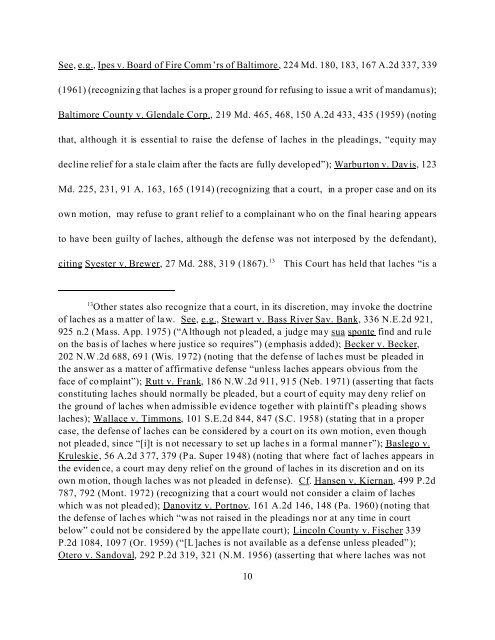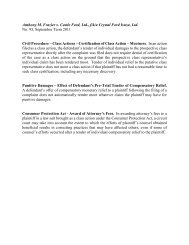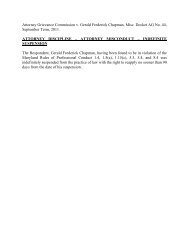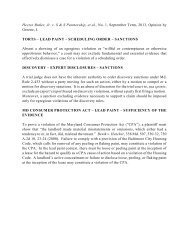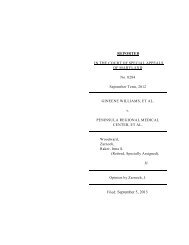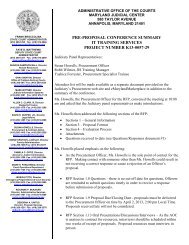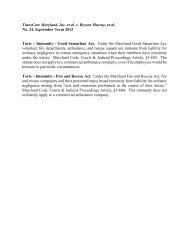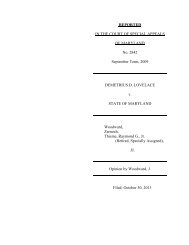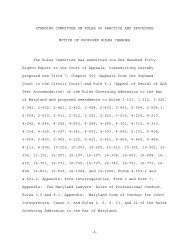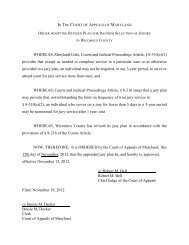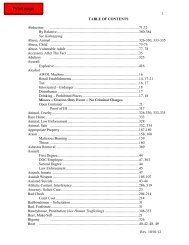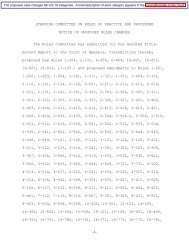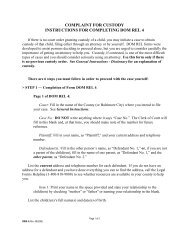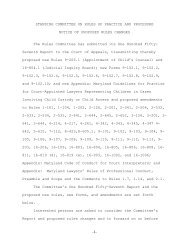Liddy v. Lamone - Maryland state court system
Liddy v. Lamone - Maryland state court system
Liddy v. Lamone - Maryland state court system
You also want an ePaper? Increase the reach of your titles
YUMPU automatically turns print PDFs into web optimized ePapers that Google loves.
See, e.g., Ipes v. Board of Fire Comm’rs of Baltimore, 224 Md. 180, 183, 167 A.2d 337, 339<br />
(1961) (recognizing that laches is a proper ground for refusing to issue a writ of mandamus);<br />
Baltimore County v. Glendale Corp., 219 Md. 465, 468, 150 A.2d 433, 435 (1959) (noting<br />
that, although it is essential to raise the defense of laches in the pleadings, “equity may<br />
decline relief for a stale claim after the facts are fully developed”); Warburton v. Davis, 123<br />
Md. 225, 231, 91 A. 163, 165 (1914) (recognizing that a <strong>court</strong>, in a proper case and on its<br />
own motion, may refuse to grant relief to a complainant who on the final hearing appears<br />
to have been guilty of laches, although the defense was not interposed by the defendant),<br />
citing Syester v. Brewer, 27 Md. 288, 319 (1867). 13 This Court has held that laches “is a<br />
13 Other <strong>state</strong>s also recognize that a <strong>court</strong>, in its discretion, may invoke the doctrine<br />
of laches as a matter of law. See, e.g., Stewart v. Bass River Sav. Bank, 336 N.E.2d 921,<br />
925 n.2 (Mass. App. 1975) (“Although not pleaded, a judge may sua sponte find and rule<br />
on the basis of laches where justice so requires”) (emphasis added); Becker v. Becker,<br />
202 N.W.2d 688, 691 (Wis. 1972) (noting that the defense of laches must be pleaded in<br />
the answer as a matter of affirmative defense “unless laches appears obvious from the<br />
face of complaint”); Rutt v. Frank, 186 N.W.2d 911, 915 (Neb. 1971) (asserting that facts<br />
constituting laches should normally be pleaded, but a <strong>court</strong> of equity may deny relief on<br />
the ground of laches when admissible evidence together with plaintiff’s pleading shows<br />
laches); Wallace v. Timmons, 101 S.E.2d 844, 847 (S.C. 1958) (stating that in a proper<br />
case, the defense of laches can be considered by a <strong>court</strong> on its own motion, even though<br />
not pleaded, since “[i]t is not necessary to set up laches in a formal manner”); Baslego v.<br />
Kruleskie, 56 A.2d 377, 379 (Pa. Super 1948) (noting that where fact of laches appears in<br />
the evidence, a <strong>court</strong> may deny relief on the ground of laches in its discretion and on its<br />
own motion, though laches was not pleaded in defense). Cf. Hansen v. Kiernan, 499 P.2d<br />
787, 792 (Mont. 1972) (recognizing that a <strong>court</strong> would not consider a claim of laches<br />
which was not pleaded); Danovitz v. Portnov, 161 A.2d 146, 148 (Pa. 1960) (noting that<br />
the defense of laches which “was not raised in the pleadings nor at any time in <strong>court</strong><br />
below” could not be considered by the appellate <strong>court</strong>); Lincoln County v. Fischer 339<br />
P.2d 1084, 1097 (Or. 1959) (“[L]aches is not available as a defense unless pleaded”);<br />
Otero v. Sandoval, 292 P.2d 319, 321 (N.M. 1956) (asserting that where laches was not<br />
10


